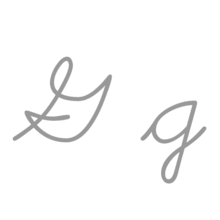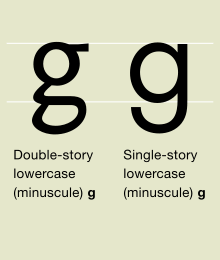G
|

G (named gee /ˈdʒiː/)[1] is the 7th letter in the ISO basic Latin alphabet.
History
The letter 'G' was introduced in the Old Latin period as a variant of 'C' to distinguish voiced /ɡ/ from voiceless /k/. The recorded originator of 'G' is freedman Spurius Carvilius Ruga, the first Roman to open a fee-paying school, who taught around 230 BC. At this time, 'K' had fallen out of favor, and 'C', which had formerly represented both /ɡ/ and /k/ before open vowels, had come to express /k/ in all environments.
Ruga's positioning of 'G' shows that alphabetic order related to the letters' values as Greek numerals was a concern even in the 3rd century BC. According to some records, the original seventh letter, 'Z', had been purged from the Latin alphabet somewhat earlier in the 3rd century BC by the Roman censor Appius Claudius, who found it distasteful and foreign.[2] Sampson (1985) suggests that: "Evidently the order of the alphabet was felt to be such a concrete thing that a new letter could be added in the middle only if a 'space' was created by the dropping of an old letter."[3]
Hempl (1899) proposes that there never was such a "space" in the alphabet and that in fact 'G' was a direct descendant of zeta. Zeta took shapes like ⊏ in some of the Old Italic scripts; the development of the monumental form 'G' from this shape would be exactly parallel to the development of 'C' from gamma. He suggests that the pronunciation /k/ > /ɡ/ was due to contamination from the also similar-looking 'K'.[4]
Eventually, both velar consonants /k/ and /ɡ/ developed palatalized allophones before front vowels; consequently in today's Romance languages, ⟨c⟩ and ⟨g⟩ have different sound values depending on context (known as hard and soft C and hard and soft G). Because of French influence, English orthography shares this feature.
Typographic variants

The modern lowercase 'g' has two typographic variants: the single-story (sometimes opentail) '![]() ' and the double-story (sometimes looptail) '
' and the double-story (sometimes looptail) '![]() '. The single-story form derives from the majuscule (uppercase) form by raising the serif that distinguishes it from 'c' to the top of the loop, thus closing the loop, and extending the vertical stroke downward and to the left. The double-story form (g) had developed similarly, except that some ornate forms then extended the tail back to the right, and to the left again, forming a closed bowl or loop. The initial extension to the left was absorbed into the upper closed bowl. The double-story version became popular when printing switched to "Roman type" because the tail was effectively shorter, making it possible to put more lines on a page. In the double-story version, a small top stroke in the upper-right, often terminating in an orb shape, is called an "ear".
'. The single-story form derives from the majuscule (uppercase) form by raising the serif that distinguishes it from 'c' to the top of the loop, thus closing the loop, and extending the vertical stroke downward and to the left. The double-story form (g) had developed similarly, except that some ornate forms then extended the tail back to the right, and to the left again, forming a closed bowl or loop. The initial extension to the left was absorbed into the upper closed bowl. The double-story version became popular when printing switched to "Roman type" because the tail was effectively shorter, making it possible to put more lines on a page. In the double-story version, a small top stroke in the upper-right, often terminating in an orb shape, is called an "ear".
Generally, the two forms are complementary, but occasionally the difference has been exploited to provide contrast. The 1949 Principles of the International Phonetic Association recommends using ![]() for advanced voiced velar plosives (denoted by Latin small letter script G) and
for advanced voiced velar plosives (denoted by Latin small letter script G) and ![]() for regular ones where the two are contrasted, but this suggestion was never accepted by phoneticians in general,[5] and today '
for regular ones where the two are contrasted, but this suggestion was never accepted by phoneticians in general,[5] and today '![]() ' is the symbol used in the International Phonetic Alphabet, with '
' is the symbol used in the International Phonetic Alphabet, with '![]() ' acknowledged as an acceptable variant and more often used in printed materials.[5]
' acknowledged as an acceptable variant and more often used in printed materials.[5]
Use in writing systems
English
In English, the letter appears either alone or in some digraphs. Alone, it represents
- a voiced velar plosive (/ɡ/ or "hard" ⟨g⟩), as in goose, gargoyle and game;
- a voiced palato-alveolar affricate (/dʒ/ or "soft" ⟨g⟩), generally before ⟨i⟩ or ⟨e⟩, as in giant, ginger and geology or
- a voiced palato-alveolar sibilant (/ʒ/) in some words of French origin, such as rouge, beige and genre.
In words of Romance origin, ⟨g⟩ is mainly soft before ⟨e⟩ (including the digraphs ⟨ae⟩ and ⟨oe⟩), ⟨i⟩, and ⟨y⟩ and hard otherwise. There are many English words of non-Romance origin where ⟨g⟩ is hard though followed by ⟨e⟩ or ⟨i⟩ (e.g. get, gift), and a few in which ⟨g⟩ is soft though followed by ⟨a⟩ such as gaol or margarine.
The digraph ⟨dg⟩ represents
- a voiced palato-alveolar affricate (/dʒ/) as in bridge or judge.
The digraph ⟨ng⟩ represents either
- a velar nasal (/ŋ/) as in length and sing, or
- a consonant cluster of the latter with the hard ⟨g⟩ (/ŋɡ/) as in jungle and finger, or
- a consonant cluster of /ndʒ/, as in sponge or binge.
The digraph ⟨gh⟩ (which mostly came about when the letter Yogh, which took various values including /ɡ/, /ɣ/, /x/ and /j/, was removed from the alphabet) now represents a great variety of values, including
- /ɡ/ word-initially and in loan words like spaghetti
- as an indicator of a letter's "long" pronunciation in words like sigh and night
- silent as in eight and plough
- /f/ in enough
- between two vowels, a simple cluster of /ɡh/ as in pigheaded
The digraph ⟨gn⟩ may represent
- initially, /n/ as in gnome and gnostic
- finally, /n/ with a preceding "long" vowel as in sign
- between two vowels, a simple cluster of /ɡn/ as in signature
- /nj/ in loanwords such as lasagna
Other languages
Most Romance languages and some Nordic languages also have two main pronunciations for ⟨g⟩, hard and soft. While the soft value of ⟨g⟩ varies in different Romance languages (/ʒ/ in French and Portuguese, [(d)ʒ] in Catalan, /d͡ʒ/ in Italian and Romanian, and /x/ in most dialects of Spanish), in all except Romanian and Italian, soft ⟨g⟩ has the same pronunciation as the ⟨j⟩.
In Italian and Romanian, ⟨gh⟩ is used to represent /ɡ/ before front vowels where ⟨g⟩ would otherwise represent a soft value. In Italian and French, ⟨gn⟩ is used to represent the palatal nasal /ɲ/, a sound somewhat similar to the ⟨ny⟩ in English canyon. In Italian, the trigraph ⟨gli⟩, when appearing before a vowel or as the article and pronoun gli, represents the palatal lateral approximant /ʎ/.
Other languages typically use ⟨g⟩ to represent /ɡ/ regardless of position.
Amongst European languages Czech, Dutch and Finnish are an exception as they do not have /ɡ/ in their native words. In Dutch ⟨g⟩ represents a voiced velar fricative /ɣ/ instead, a sound that does not occur in modern English, but there is a dialectal variation: many Netherlandic dialects use a voiceless fricative ([x] or [χ]) instead, and in southern dialects it may be palatalized to [ʝ]. Nevertheless, word-finally it is always voiceless in all dialects, including the standard Dutch of Belgium and the Netherlands. On the other hand, some dialects (like Amelands), may have a phonemic /ɡ/.
Faroese uses ⟨g⟩ to represent /dʒ/, in addition to /ɡ/, and also uses it to indicate a glide.
In Maori (Te Reo Māori), ⟨g⟩ is used in the digraph ⟨ng⟩ which represents the velar nasal /ŋ/ and is pronounced like the ⟨ng⟩ in singer.
In older Czech and Slovak orthographies, ⟨g⟩ was used to represent /j/, while /ɡ/ was written as ⟨ǧ⟩ (⟨g⟩ with caron).
Related characters
Ancestors, descendants and siblings
- 𐤂 : Semitic letter Gimel, from which the following symbols originally derive
- C c : Latin letter C, from which G derives
- Γ γ : Greek letter Gamma, from which C derives in turn
- ɡ: Latin letter script small G
- Г г : Cyrillic letter Ge
- Ȝ ȝ : Latin letter Yogh
- Ɣ ɣ : Latin letter Gamma
- ɢ : Latin letter small capital G, used in the International Phonetic Alphabet to represent a voiced uvular stop
- G with diacritics: Ǥ ǥ Ĝ ĝ Ğ ğ Ģ ģ Ɠ ɠ Ġ ġ
Ligatures and abbreviations
Computing codes
| Character | G | g | ɡ | |||
|---|---|---|---|---|---|---|
| Unicode name | LATIN CAPITAL LETTER G | LATIN SMALL LETTER G | LATIN SMALL LETTER SCRIPT G | |||
| Encodings | decimal | hex | decimal | hex | decimal | hex |
| Unicode | 71 | U+0047 | 103 | U+0067 | 609 | U+0261 |
| UTF-8 | 71 | 47 | 103 | 67 | 201 161 | C9 A1 |
| Numeric character reference | G | G | g | g | ɡ | ɡ |
| EBCDIC family | 199 | C7 | 135 | 87 | ||
| ASCII 1 | 71 | 47 | 103 | 67 | ||
- 1 Also for encodings based on ASCII, including the DOS, Windows, ISO-8859 and Macintosh families of encodings.
Other representations
See also
- Carolingian G
- hard and soft G
- insular G
- letter G in freemasonry
- Latin letters used in mathematics#Gg
References
- ↑ The American Heritage Dictionary of the English Language. 1976.
- ↑ Encyclopaedia Romana
- ↑ Evertype.com
- ↑ Hempl, George (1899). "The Origin of the Latin Letters G and Z". Transactions and Proceedings of the American Philological Association. The Johns Hopkins University Press. 30: 24–41. doi:10.2307/282560. JSTOR 282560.
- 1 2 Pullum, Geoffrey K.; Ladusaw, William A. (1986). Phonetic Symbol Guide. Chicago & London: The University of Chicago Press. p. 58.
External links
 Media related to G at Wikimedia Commons
Media related to G at Wikimedia Commons The dictionary definition of G at Wiktionary
The dictionary definition of G at Wiktionary The dictionary definition of g at Wiktionary
The dictionary definition of g at Wiktionary- Lewis and Short Latin Dictionary: G


